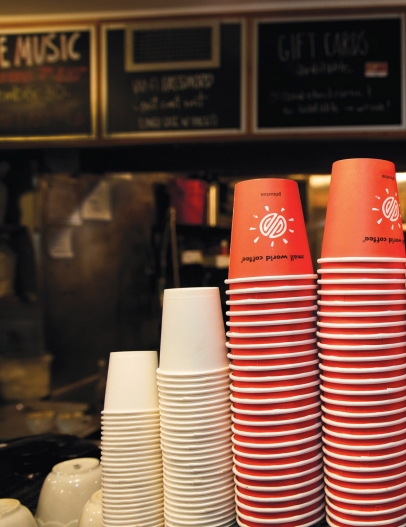Small World Coffee is Building Community in Princeton
When author Eric Baum sent a thank-you copy of What is Thought? to Jessica Durrie, co-owner of Small World Coffee in Princeton, he included a personal note expressing gratitude for the “stimulating, friendly environment” and “delicious coffee” that fueled the writing of his book. “It’s a pleasure,” he wrote, “to work surrounded by art, by people reading Heidegger and Wittgenstein, by people chatting about subjects deep or frivolous or both.”
Writing in cafés enjoys a storied history, and in a town that has been home to so many authors and academics of note, it’s no surprise to find Small World customers earnestly typing and scribbling away, enjoying a creative boost from the café’s energetic pace. Those writers join a legion of “regulars” who stop in multiple times a week to recharge after a morning run, grab coffee on the way to work, take a mid-day break, or use the café as an informal meeting space.
Retaining those regulars depends, in part, on the café providing a welcoming environment while delivering exceptional coffee that has a consistent flavor profile over time. Small World’s three-decade-long track record of success reflects co-owner Brant Cosaboom’s obsession with controlling as many aspects of coffee quality as possible and Durrie’s commitment to creating a service-focused company culture. The duo’s vision is executed by a disciplined but quirky team of “Worldlings” who make the café hum and make a diverse clientele feel at home.
When Cosaboom and Durrie first met as baristas at Espresso Royale in Ann Arbor, Michigan, they found they shared a passion for the focused energy and teamwork needed to make a busy café both successful and beloved. “Espresso Royale was really getting going in 1988. They were right there at the very beginning of this whole coffeehouse craze,” Cosaboom says. “It was a new industry that had never really existed in its current incarnation. I think it was the newness of this industry that attracted an incredible amount of just amazing people.”
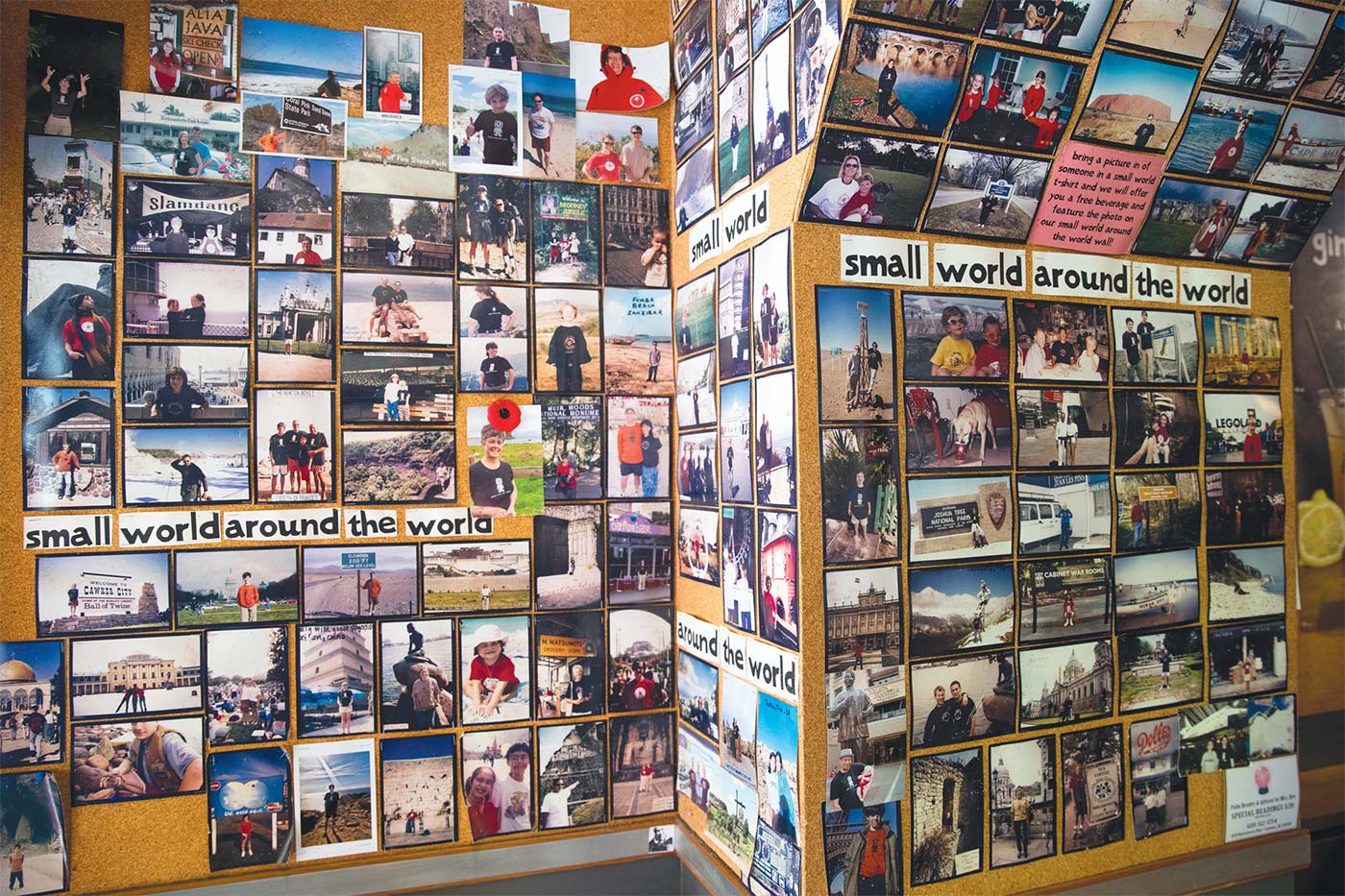
THAT IDEA OF TAKING CARE OF EACH OTHER IS PART OF THE ETHOS OF SMALL WORLD…. THE FOUNDATION OF THAT ETHOS RESTS ON FIVE VALUES: AUTHENTICITY, GENEROSITY, INCLUSIVITY, SUSTAINABILITY, AND HARD-CORE WORK ETHIC.
Cosaboom and Durrie eventually set off on a cross-country search for a college town in which to open their own café—one that would match the energy of Espresso Royale. “I wanted a place that had really good, energetic, authentic service,” Durrie says. “I wanted it to be a convivial place for the community. But I wanted to kick ass at it. I didn’t want to have a quiet café. We knew that we got a lot of energy from serving a line and we knew how to do that well.”
Visiting Cosaboom’s parents in Princeton in fall 1992, they found the mix of walkability, diversity, and retail-residential mix that they had been seeking. Small World Coffee opened on Witherspoon Street in December 1993—a heady time in the specialty coffee industry with Starbucks going public in 1992 and independent coffeehouses opening up across the U.S., offering communities a new “third place” in which to gather.
Coffee: A Focus on Precision
When coffee drinkers order the same drink from the same coffee shop day after day, they can often detect subtle changes in the taste, which can result from a myriad of factors—ranging from variations in the roast to the experience level of the barista. To help ensure flavor consistency, Cosaboom roasts all the coffee for the café in Small World’s roastery, which is located a few miles north of Princeton. This enables him to control the freshness, ensure the quality of the beans, and fine tune the roasting in response to seasonal and geographic variations in those beans. Along with roastery partner Jon March, another veteran of Espresso Royale, he developed Small World’s signature East Coast Roast—a finely tuned middle point between light and dark roast that Cosaboom describes as “a really fussy process to get just right, where you don’t get too much bitterness and you don’t get too much sourness.” (See sidebar on flavor.)
Having a roastery allows Cosaboom to bring roasting and brewing into alignment. “The roast development and the brew extraction are two different processes that you want to have in sync,” he says. “If you roast one way, you want to extract to complement that roast style. If you don’t know how your coffee is being roasted, or what inconsistencies might be in that roasting process, it’s very hard to consistently dial in your extraction and know when you need to modify aspects of it.”
Because the café’s brewed coffee is made in large batches, Cosaboom and March must take into account that, as brewed coffee cools, the flavor changes. “We serve it quickly, but the coffee, in general, is 10 to 15 minutes old when you’re tasting it,” Cosaboom says. “It’s important for me to know what this tastes like when it’s cooled off three to five degrees and sat in an urn for a little bit. How does it change? Does it still taste good?”
They address this challenge, in part, by creating blends of coffee beans from different parts of the world. “They all perform slightly differently at different times and temperatures,” Cosaboom says. “You might get one range of flavors when it’s freshly brewed, but you get a different flavor when it’s closer to room temperature.” Their goal in blending is that, even as the coffee cools in the cup, the flavor remains enjoyable.
Visiting techs perform weekly maintenance to keep the espresso machines, brewing equipment, and grinders in proper working order. An in-house filtration system maintains water quality. And twice-weekly roasting allows the café to keep the freshness of the beans they use consistent.
“I very much like three- to six-day-old roasted coffee for espresso,” Cosaboom says. “If it’s too young or too old, it won’t extract the same way. It might have good flavor, but it won’t be the same.”
Once the roasted coffee is delivered to the café, it’s up to the baristas to retain flavor consistency by paying close attention to the espresso as they make it—adjusting the fineness of the grind and the timing of the shot as needed. “I can teach almost anyone to make coffee,” says Tuc Sargentini, Small World’s head trainer. “It’s not very difficult. The challenging part is doing it in volume while maintaining quality. It’s not just ‘Press the button, make the thing happen.’ It’s ‘Press the button, make the thing happen, and observe. Is this within the parameters we’ve set up? Does this taste right?’ Speed without quality is just wasted effort.”
Sargentini also keeps an eye on the bus trays to see if customers are discarding half-finished cups. “If I start seeing a pattern, then I check in and am kind of, like, ‘Let me taste the espresso or observe your practices to see if there’s something,’” he says. “Sometimes it’s just an anomaly, but sometimes that’s a tipoff that something’s out of adjustment.”
“I WANTED TO KICK ASS AT IT. I DIDN’T WANT TO HAVE A QUIET CAFÉ. WE KNEW THAT WE GOT A LOT OF ENERGY FROM SERVING A LINE AND WE KNEW HOW TO DO THAT WELL.” —Jessica Durrie
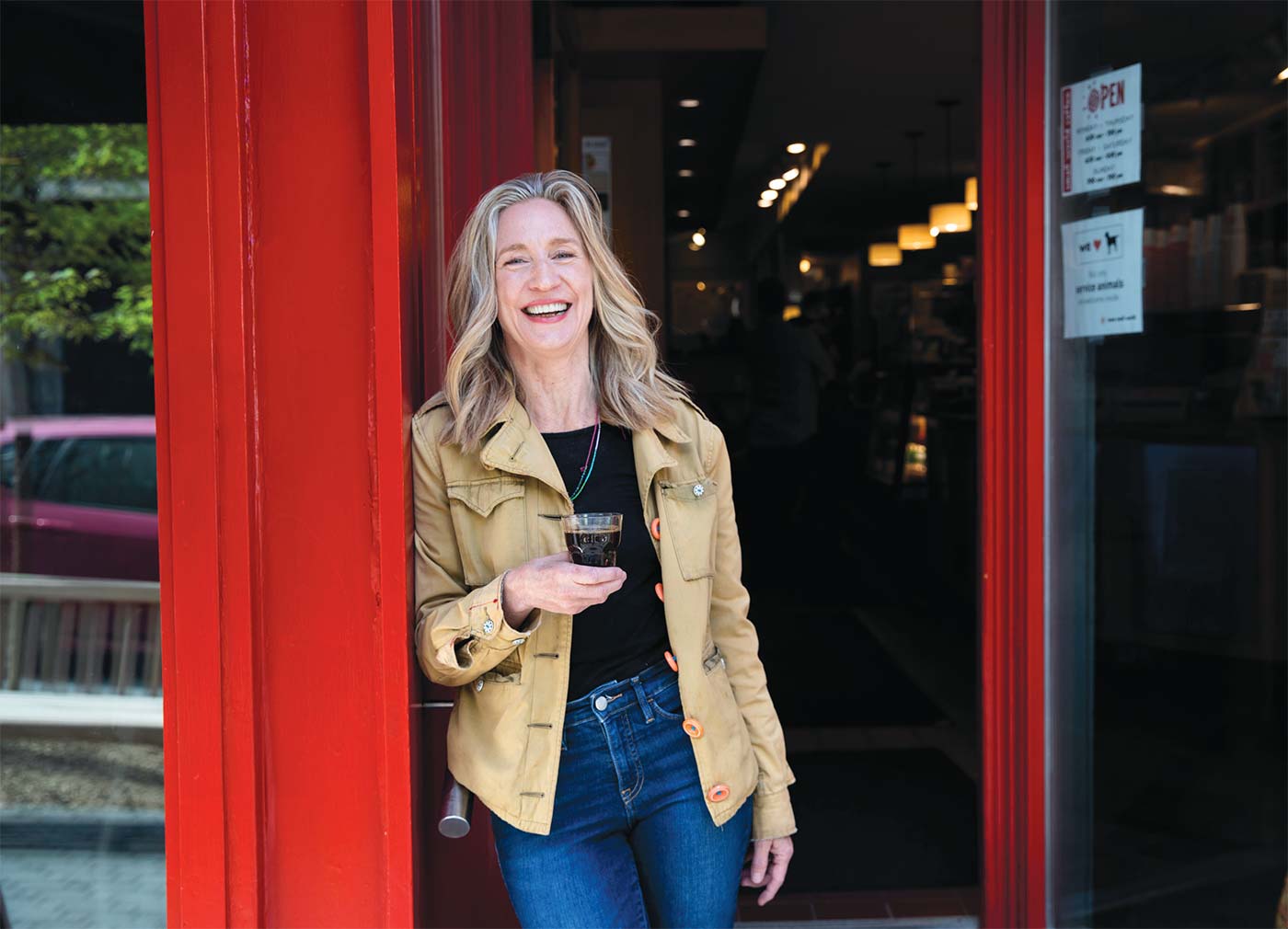
Culture: Building a Tight Team
Cosaboom believes that the perception of flavor is also impacted by the experience that customers have when they purchase their coffee. “It’s really making sure people feel taken care of,” he says. “That they’re not frustrated by how long they’ve had to wait, that they’re treated with courteousness and respect—are all part of the quality of the product that we’re serving.” His goal is for customers to get their coffee within a maximum of seven minutes of standing on line. The café’s ability to do that is why regulars can sometimes be overheard in line assuring wary first timers that, despite a long line, they will be served quickly.
The company standard for well-executed coffee in a welcoming atmosphere was set by baristas Marc Goldberg and Max Shane, who were both recruited from Espresso Royale during the opening of Small World. “Marc and Max had such an imprint on the beginnings of our culture because they were 100 percent authentic behind the counter,” Durrie says. “They imprinted the ‘hard-core work ethic while having fun’ into our culture. There would have been no way that we would have been able to train all the people we had to train, and impart that feeling, without those guys.”
To thrive as a Worldling, Sargentini says, you must play well with others, reliably do what you say you’re going to do, and have the ability to juggle many things, which he explains as “take chaos, be able to organize it, hold on to it for a moment, and then let it go.”
Training to make coffee takes several months—a timeline that varies, Sargentini says, with the employee’s learning style. “One of the things I try to do when I’m meeting people is find out what their learning style is and try to match the things we do here to that,” says Sargentini, who has worked at Small World since October 1994. “We need to generate a profit, but the ethic presented to me always—since forever—has been that we do that by taking care of the staff. If the staff feel they’re respected and taken care of, they spread that around. And so, while I definitely want someone to get to a certain point—there are benchmarks—it’s on their timeline.”
That idea of taking care of each other is part of the ethos of Small World that Durrie has worked for years to develop and fine tune. The foundation of that ethos rests on five values: authenticity, generosity, inclusivity, sustainability, and hard-core work ethic.
Creating an inclusive café has been a goal since Small World opened. And generosity, she explains to new hires, can take non-monetary forms, such as paying attention to someone.
“With authenticity,” Durrie says, “I tell the team when they get hired, ‘You’re going to learn all the mechanics. You don’t know the rules yet. You don’t know the priorities. You don’t know how to do anything. So, in the beginning, you’ve just got to learn, learn, learn and become a competent Worldling and be able to contribute more and more every day. Once all those mechanics become second nature, then we want you to bring your personality to the table—because customers love the coffee, but they also love interacting with the people behind the counter. I’m not telling you how to interact with the public. Bring your own flair to the table.’”
By flair, she means that Worldlings should present an authentic self in interactions with customers and co-workers. That’s easier to do, Durrie says, when employees feel that they matter, trust that coworkers have their back, and know that it’s OK to make a mistake. She defines the process as building community from the inside out. “We first have to take care of each other,” she says. “If we can’t be sympatico with one another, then we’re not going to be able to give good service to the customers. But if we’re doing our job right in hiring and training and making our employees feel like they belong, then they’re going to have a much easier time connecting with the customers.”
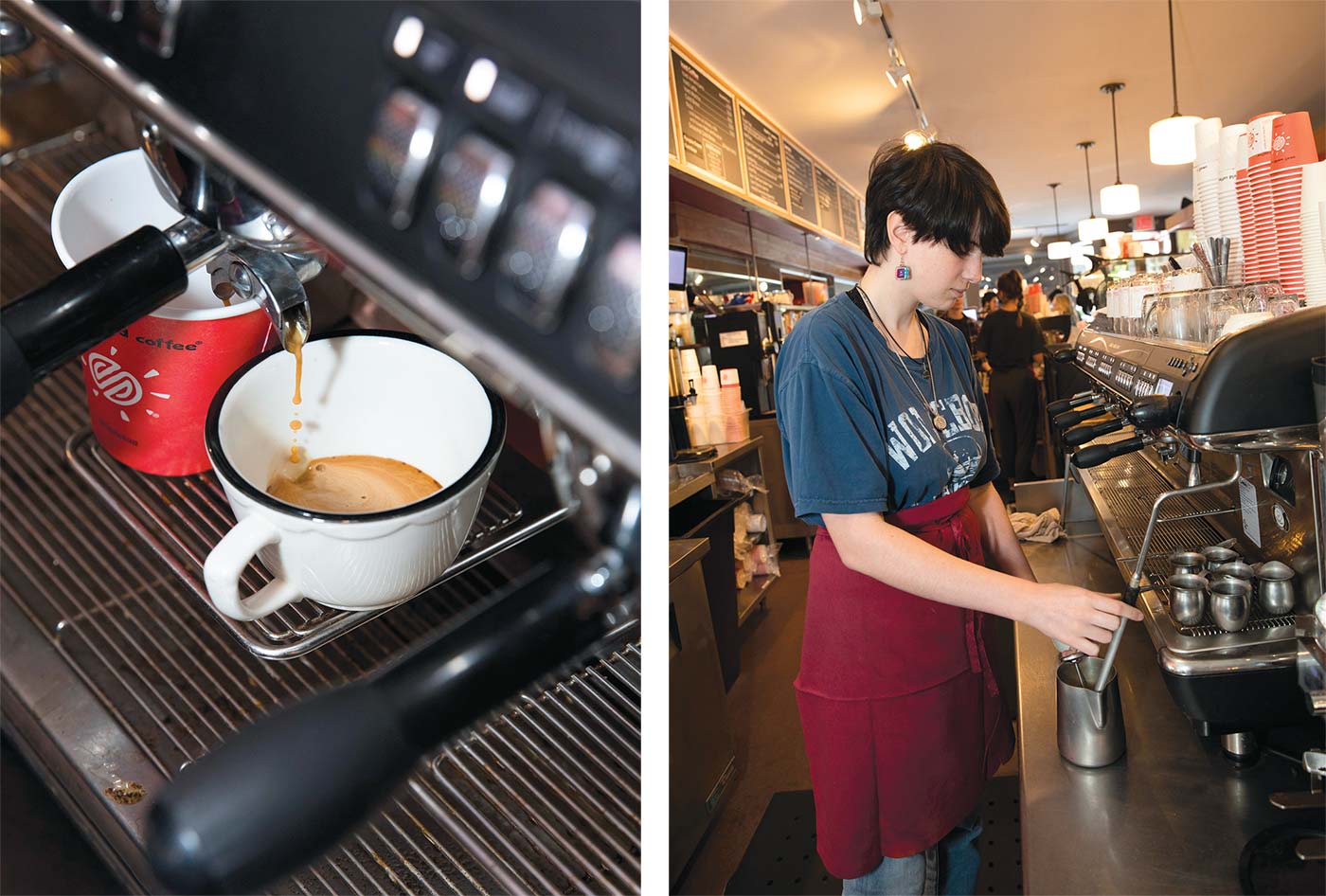
“WE WANT YOU TO BRING YOUR PERSONALITY TO THE TABLE—BECAUSE CUSTOMERS LOVE THE COFFEE, BUT THEY ALSO LOVE INTERACTING WITH THE PEOPLE BEHIND THE COUNTER.”
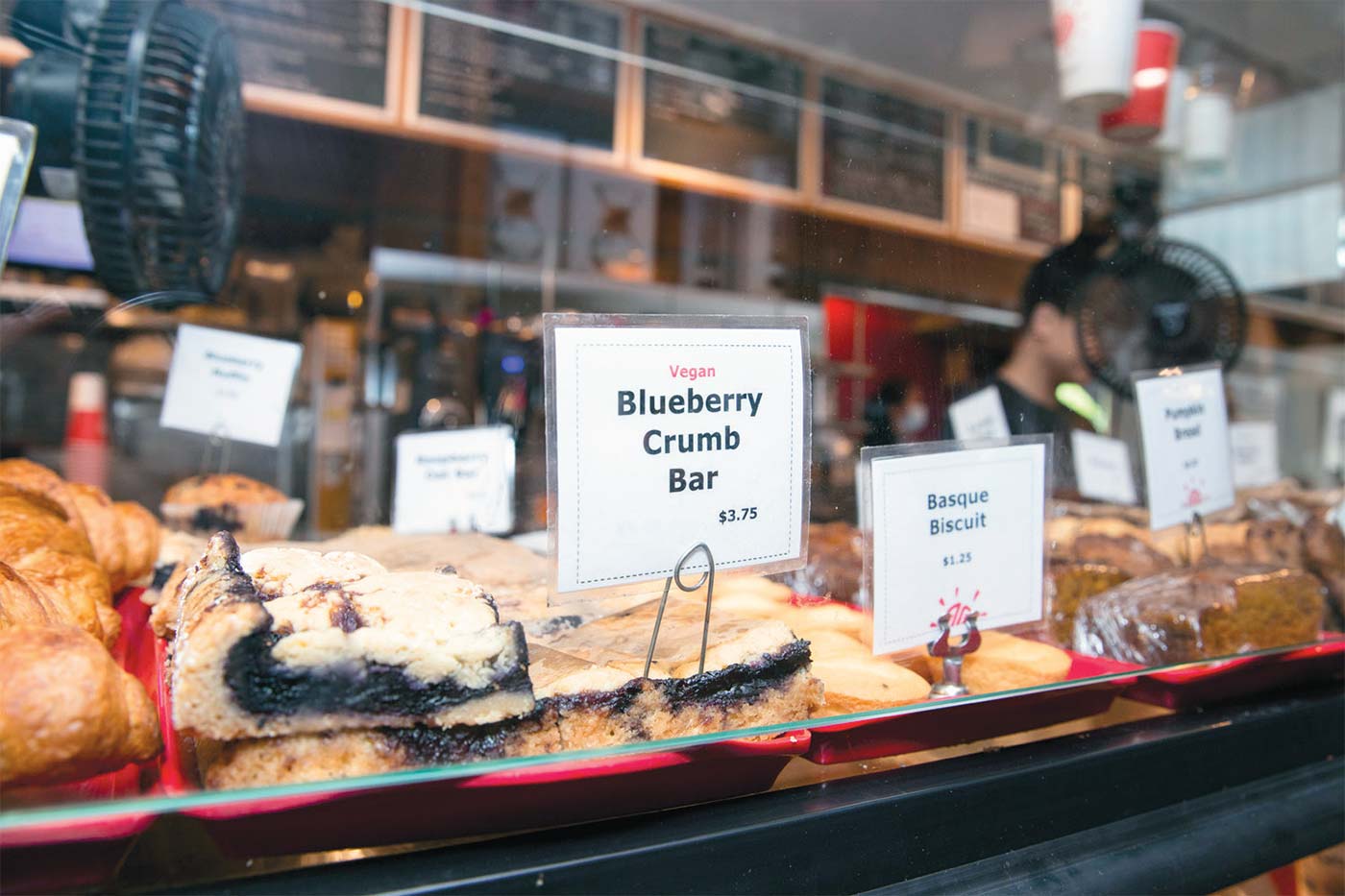
Finding the Flavor at Small World Coffee
In choosing the darkness level at which to roast, Brant Cosaboom aims for a balance that allows his customers to taste the flavor of both the beans and the roasting process. Too dark, says the co-owner of Small World Coffee and Small World Roaster, and it obscures the flavor of the bean. Too light and the coffee becomes sour as it cools.
“The darker you roast, the more you develop body and richness and chocolate flavors, but the less you can taste the distinct varietal characteristics of the beans themselves,” he says. “At a certain level of darkness or richness, you can’t really taste the varietal characteristics anymore. But if you don’t go [a little] dark, then, especially as beverages cool off, they sour and get overly acidic or tangy.”
In comparison to many artisan coffee roasters, Cosaboom is considered a dark roaster. “For me, it’s richness, complexity of flavors, and length of finish,” he says. “That’s part of why we roast darker—because it gives you this baseline of body and richness and caramel and chocolate flavors that are part of the roast process, not inherent in the beans.”—F.M.
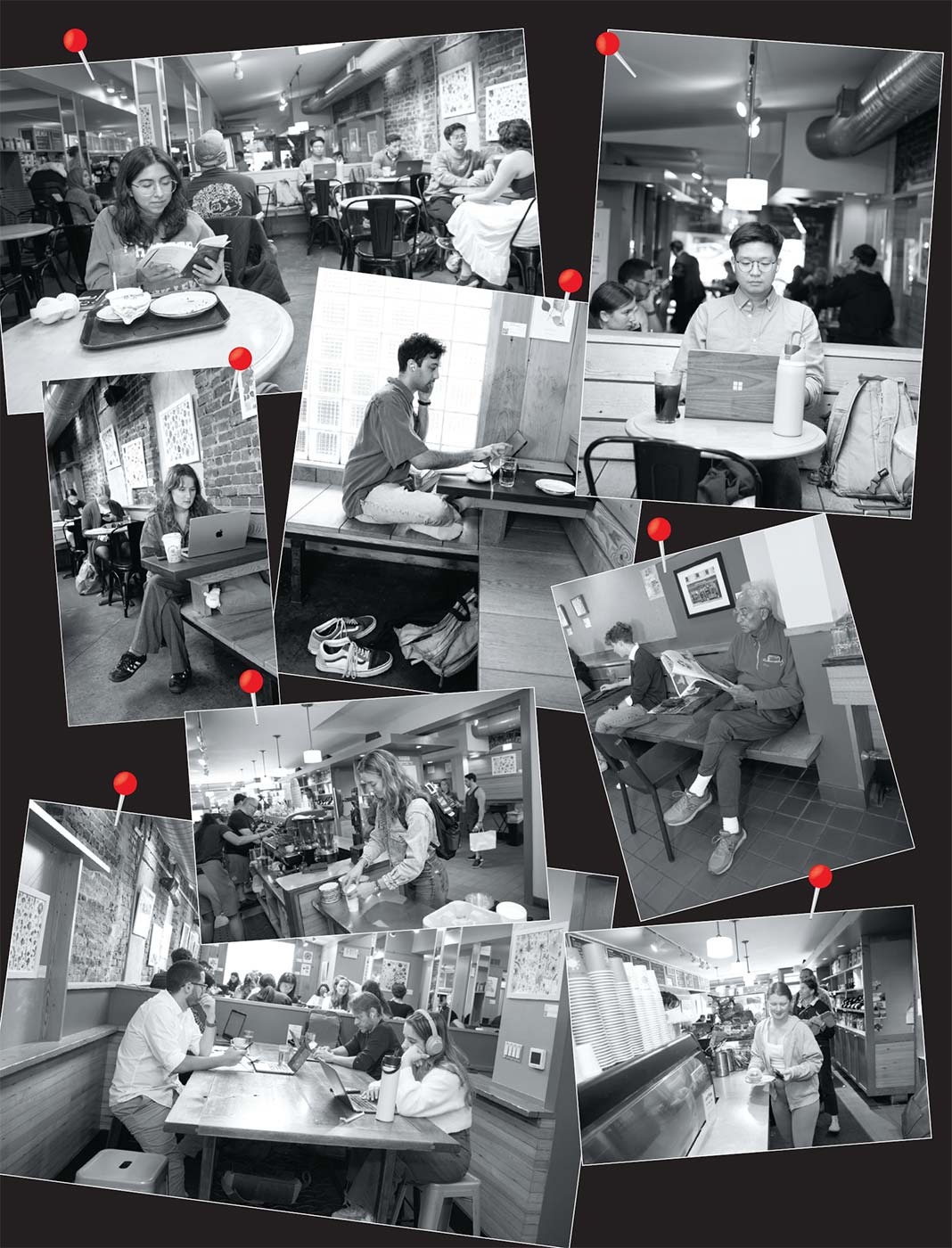
Community: Making Each Feel Welcome
It is the Worldlings who create a convivial atmosphere in the café—even down to shift managers choosing the music that’s being played, which they match to the café’s vibe and energy at that time of the day and week.
“A goal for our staff and for our interactions with the community is to create that sense of belonging,” says Sargentini. “A main reason that we’ve been successful is we consistently do that: create a community atmosphere where people feel like they belong, even if you’re here for the first time.”
In his staff training, Sargentini instructs Worldlings to pay attention when someone walks in the door and to ask themselves “Do I recognize them? How oriented are they to this space? What is their body language?” If it is someone who comes in every day, they likely don’t need help navigating the ordering process. First-time guests, however, may need guidance. The important thing, he tells the staff, is to treat each customer as an individual. Sargentini illustrates that point with a riddle. “How do you serve a thousand people well? The answer is you serve a thousand people well by serving one person well a thousand times,” he says. “It does not matter if the line is out the door and wrapped around the corner. Ultimately, whoever is in front of you is important.”
In addition to interactions happening across the counter, Durrie observes many serendipitous interactions happening between customers. “A lot of people come in at the same time every day. So, you’ll inevitably, over time, be in line with the same people and see each other over and over and over again. That breaks down boundaries and creates this sense of affiliation. And then sometimes you make friends.”
“Or,” she adds with a knowing laugh, “you get married eventually.”

Some of the Worldlings & years on the job: standing, l to r: Kahlou Brown, kitchen manager (3 years), Vin Jule, general manager (22 years); Malena Brown, Witherspoon manager (20 years), Tuc Sargentini, head trainer (29 years); Kale Taylor Thompson, Nassau manager (on and off over 13 years) on bench, l to r: Jessica Durrie and Brant Cosaboom, coowners of Small World Coffee and Small World Roasters; Jon March, partner at Small World Roasters and lead roaster
30 Years of Consistency & Commitment: Cup After Cup
Sargentini remembers Eric Baum coming into the café daily to write. And, almost 20 years later, he’s pretty sure that the author’s usual drink was a double Joe. That community memory, along with deep institutional knowledge, exists because of a core group of Worldlings who have been with the company for more than a decade—passing along their accumulated skills and knowledge to each new member of the Worldling team.
“Every time we train someone, we get better at doing it,” Durrie says. “When I do the panorama of so many influential Worldlings that we’ve had here over the years—so many have left their mark to this day, even though people that are here now don’t know that.”
That embedded shared knowledge is how Worldlings consistently deliver on Cosaboom and Durrie’s priorities of offering great coffee, served at lightning speed, in a friendly atmosphere. And the reciprocal sense of being seen—regardless of which side of the counter you are on—is a potent connecting force in a café that fuels the caffeine habits of constant waves of new students, returning alumni, tourists, and conference goers, as well as the steady stream of loyal regulars.
When Cosaboom and Durrie reflect on what makes Small World a beloved community gathering spot, they return to that joy of working with a committed, engaged team that they experienced as young baristas at Espresso Royale.
“Excellence isn’t really a secret,” Cosaboom says. “It’s a willingness to do the hard work and attend to the details over and over and over again. I can tell anyone the way I roast—and the one in a million that’s willing to do it, they’re my friends because they’re of like mind.”
For Durrie, the secret to the company’s success is summed up in a farming analogy used by Kale Taylor-Thompson, manager at Small World’s Nassau Street location, who observes that Cosaboom and Durrie planted the first seed and then built the fertile soil in which generations of Worldlings have been able to thrive.
“This place does not exist because of me anymore,” Durrie says. “There’s a team of people that know how to do so much of it better than I do. I know that my little zhuzh is important, but I’m not behind that counter 40 hours a week. I’m not the one making all those customers feel like they belong and adding the buzz in the air.”
“That,” she concludes, “is the culmination of 30 years of really good choices on seeds that we’ve nurtured and grown.”
Small World Coffee
14 Witherspoon Street, Princeton
Also: 254 Nassau Street, Princeton
smallworldcoffee.com
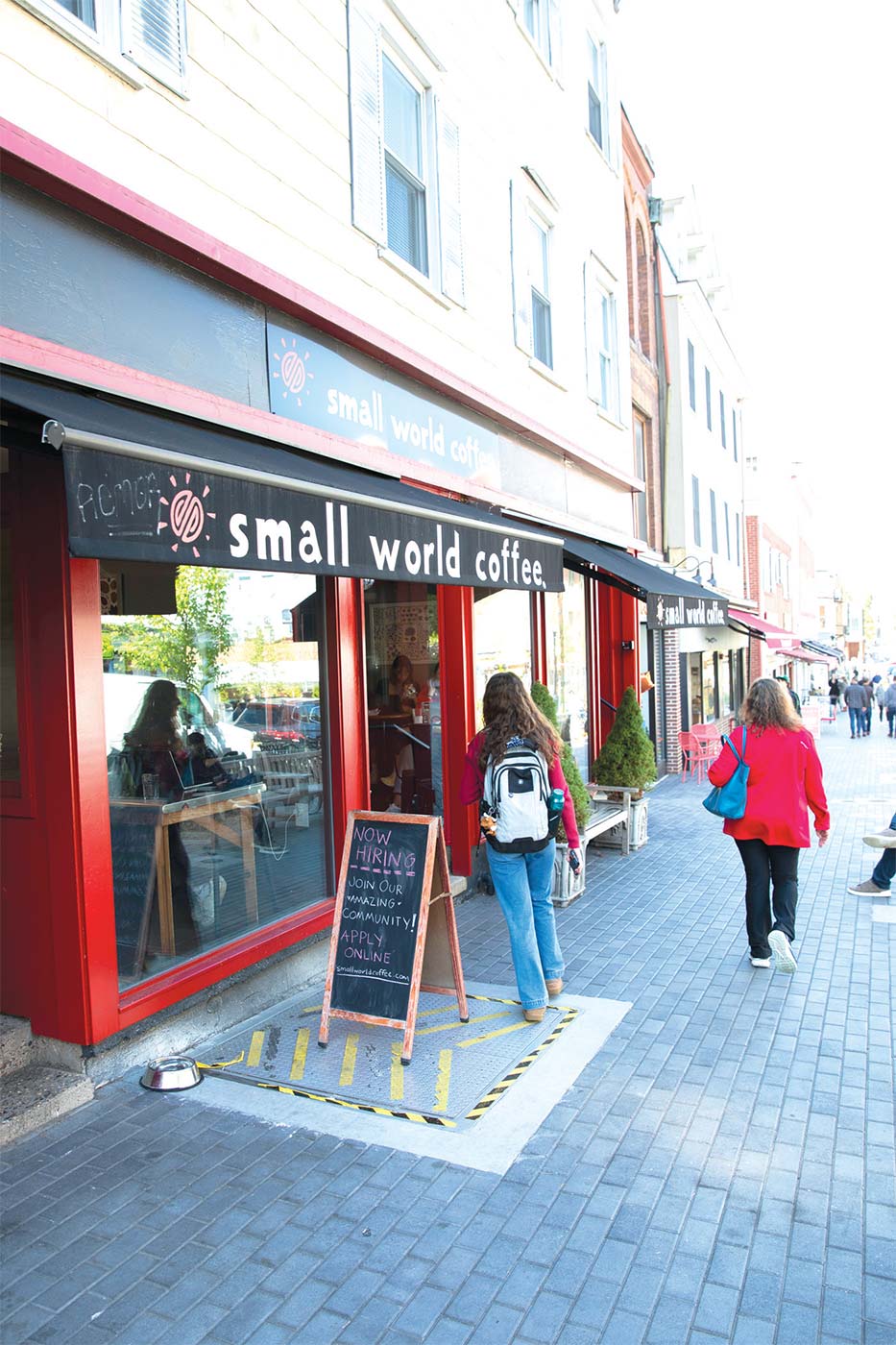
SMALL WORLD COFFEE 30th ANNIVERSARY EVENTS
In his September 6th Opinion column in the NYT, Nicholas Kristof shared a link to the Surgeon General’s report declaring that loneliness is a national health crisis. After reading the column, Jessica Durrie was inspired to weave the themes of togetherness, connection, and community into Small World’s 30th anniversary celebration events. Here is a sampling of what they have planned for December:
30th Anniversary Coffee Tin filled with Small World’s Original House Blend: for sale exclusively at Small World Coffee’s two cafes, available after Thanksgiving.
Community Mural: Small World is sponsoring the Arts Council of Princeton’s mural on Spring Street in Princeton, asking the artist to create a visual idea around connection and community.
Townwide Community Partners Celebration: To showcase the interwoven stories and relationships that have grown out of Small World Coffee, Durrie is inviting local businesses and non-profits that they work with to join in the cafe’s anniversary celebration, starting December 1, in a way that depicts how working together, forging relationships, and leaning into one another helps us to flourish together. Look for a display of coffee books at Labyrinth Books, a “Guess the Number of Coffee Beans in the Jar” contest at jaZam’s toy store, Small World Coffee Espresso Martini at Mistral, Small World Coffee ice cream at The Bent Spoon, and more.
Better Together Stroll: Visit community partner merchants, find the hidden Small World cup, and get your 30th Anniversary punch card stamped (no purchase necessary). The first 30 people to return their fully stamped card will get a goody bag with treats from Small World and some of the participating merchants. On the Anniversary Day (12/22) a winner will be drawn for a Moccamaster RBG Coffee Maker.
Share a Memory Contest: Customers are invited to share their favorite Small World memory on Instagram throughout December. Those memories will be shared by Small World and a randomly chosen participating will receive a generous prize. Tag @swcoffee.
Opening Day Celebration: Small World opened on December 22, 1993, at 3PM. Thirty years later, at 3pm, founding Worldlings Marc Goldberg and Max Shane will be back behind the counter helping to serve the line. Slices of birthday cake from Olive’s will be passed out as well. Follow Small World on Facebook and Instagram for updates. —F.M.


